In today’s rapidly evolving digital landscape, businesses must adapt and innovate to stay ahead of the curve. The digital age presents both unprecedented opportunities and challenges for organizations of all sizes. To thrive in this environment, a comprehensive approach to digital transformation is essential. This guide will provide a roadmap for driving business success in the digital age, covering key aspects of digital strategy, technology adoption, customer experience, and data-driven decision-making.
By embracing digital transformation, businesses can unlock new revenue streams, enhance operational efficiency, improve customer satisfaction, and gain a competitive edge. This guide will explore the latest trends and best practices, empowering you to navigate the complexities of the digital world and achieve sustainable growth. Whether you’re a small startup or a large enterprise, the principles outlined here can help you harness the power of technology to achieve your business goals.
Understanding Digital Transformation: Reshaping the Business Landscape
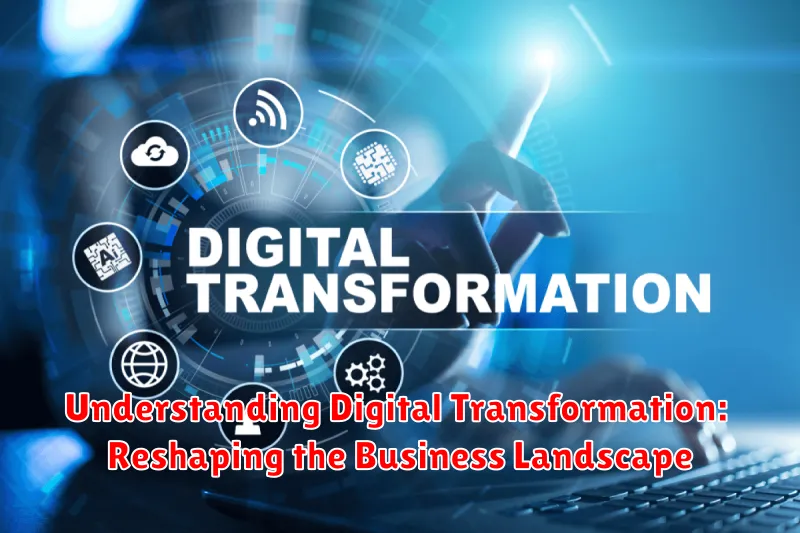
In today’s fast-paced and ever-evolving digital world, businesses are under immense pressure to adapt and thrive. The concept of digital transformation has emerged as a critical driver of success, enabling organizations to leverage technology to fundamentally change how they operate, interact with customers, and create value. This article delves into the multifaceted nature of digital transformation, exploring its key elements, benefits, and challenges.
At its core, digital transformation is a strategic process that involves embracing digital technologies to enhance business processes, create new products and services, and improve customer experiences. It encompasses a wide range of initiatives, including cloud computing, artificial intelligence (AI), big data analytics, the Internet of Things (IoT), and mobile technologies. These technologies empower businesses to automate tasks, gain insights from data, and connect with customers in innovative ways.
The Benefits of Digital Transformation
The adoption of digital transformation brings numerous benefits to organizations, including:
- Enhanced Efficiency: By automating processes and streamlining workflows, businesses can optimize operations and increase productivity. This frees up valuable resources to focus on higher-value activities.
- Improved Customer Experience: Digital technologies enable personalized customer interactions, providing tailored experiences that enhance satisfaction and loyalty.
- New Revenue Streams: Digital transformation allows businesses to develop innovative products and services, opening up new revenue opportunities and expanding market reach.
- Data-Driven Decision Making: By leveraging big data analytics, businesses gain valuable insights into customer behavior, market trends, and operational efficiency, empowering data-driven decision making.
- Competitive Advantage: Businesses that embrace digital transformation gain a competitive edge by staying ahead of the curve and adapting to changing market dynamics.
Challenges of Digital Transformation
While the benefits of digital transformation are undeniable, businesses also face several challenges:
- Resistance to Change: Employees may resist adopting new technologies and changing work practices, leading to implementation hurdles.
- Data Security and Privacy: Digital transformation involves handling large amounts of sensitive data, making data security and privacy a paramount concern.
- Cost and Complexity: Implementing digital transformation initiatives can be costly and complex, requiring significant investments in technology, infrastructure, and training.
- Lack of Skills: Businesses may struggle to find employees with the necessary digital skills to effectively implement and manage digital transformation initiatives.
Overcoming the Challenges
To successfully navigate the challenges of digital transformation, businesses need to adopt a strategic and phased approach:
- Start with a Clear Vision: Define a clear vision for digital transformation that aligns with business goals and targets specific areas for improvement.
- Foster a Culture of Innovation: Encourage experimentation, collaboration, and a willingness to embrace change throughout the organization.
- Invest in Training and Development: Equip employees with the skills and knowledge needed to effectively leverage digital technologies.
- Prioritize Data Security: Implement robust security measures to protect sensitive data and comply with privacy regulations.
- Measure Progress and Adapt: Regularly assess the impact of digital transformation initiatives and make necessary adjustments to optimize results.
Conclusion
Digital transformation is not just a technological shift but a fundamental change in how businesses operate. By embracing digital technologies, organizations can unlock tremendous opportunities for growth, innovation, and customer satisfaction. While challenges exist, a strategic and phased approach, coupled with a commitment to change, can help businesses navigate the digital landscape and achieve transformative results.
The Benefits of Embracing Digital Transformation

In today’s rapidly evolving technological landscape, businesses are increasingly recognizing the paramount importance of digital transformation. This fundamental shift involves leveraging digital technologies to fundamentally alter how organizations operate, deliver value, and interact with customers, partners, and employees. Embracing digital transformation can unlock a myriad of benefits that can propel businesses towards unprecedented success.
Enhanced Customer Experience
At the heart of any successful business lies a commitment to providing exceptional customer experiences. Digital transformation empowers businesses to deliver personalized and engaging interactions across all touchpoints. By leveraging data analytics, businesses can gain deeper insights into customer preferences, behaviors, and needs, enabling them to tailor products, services, and communications to individual customers. This personalization fosters stronger customer relationships, increased loyalty, and ultimately, higher customer satisfaction.
Increased Efficiency and Productivity
Digital technologies can significantly streamline operations and boost productivity throughout the organization. Automation, for example, can automate repetitive tasks, freeing up employees to focus on higher-value activities. Cloud computing provides access to scalable resources and infrastructure, enabling businesses to adapt to changing demands and optimize resource allocation. By leveraging these and other digital tools, businesses can significantly reduce costs, improve efficiency, and accelerate time-to-market.
Improved Decision-Making
Data is the lifeblood of any successful digital transformation strategy. By collecting, analyzing, and interpreting data from various sources, businesses can gain invaluable insights into market trends, customer behavior, and operational performance. These insights empower organizations to make data-driven decisions that are more informed, accurate, and strategic, leading to better outcomes and improved business performance.
Innovation and Competitive Advantage
Digital transformation is not just about adopting new technologies; it’s about fostering a culture of innovation and agility. By embracing digital tools and processes, businesses can explore new business models, develop innovative products and services, and respond quickly to changing market conditions. This agility and responsiveness are essential for staying ahead of the competition and maintaining a competitive edge.
Conclusion
Embracing digital transformation is no longer an option; it’s a necessity for businesses to thrive in today’s digital age. By leveraging the power of digital technologies, businesses can enhance customer experiences, improve efficiency and productivity, make data-driven decisions, and drive innovation. The benefits of digital transformation are undeniable, and organizations that fail to adapt will risk falling behind in the ever-evolving digital landscape.
Key Technologies Driving Digital Transformation

Digital transformation is the process of using technology to fundamentally change how businesses operate. It is a broad term that encompasses a wide range of activities, from adopting new technologies to changing business processes and culture. Digital transformation is driven by a number of key technologies, including:
Cloud Computing
Cloud computing is the delivery of computing services—including servers, storage, databases, networking, software, analytics, and intelligence—over the Internet (“the cloud”) to offer faster innovation, flexible resources, and economies of scale. It allows businesses to access computing resources on demand, without having to invest in their own infrastructure. This can be a significant cost savings, and it can also allow businesses to scale their operations quickly and easily.
Artificial Intelligence (AI)
Artificial intelligence (AI) is a branch of computer science that deals with the creation of intelligent agents, which are systems that can reason, learn, and act autonomously. AI is being used to automate tasks, improve decision-making, and create new products and services. Some examples of AI applications include chatbots, fraud detection, and image recognition.
Big Data and Analytics
Big data is the large volume of data—both structured and unstructured—that inundates a business on a day-to-day basis. It is generated from a variety of sources, including social media, customer interactions, sensors, and machine-to-machine communications. Big data analytics is the process of examining large datasets to uncover hidden patterns, trends, and insights. This information can be used to improve business operations, develop new products and services, and make better decisions.
Internet of Things (IoT)
The Internet of Things (IoT) is a network of physical devices, vehicles, home appliances, and other items embedded with electronics, software, sensors, actuators, and network connectivity that enables these objects to collect and exchange data. The IoT is creating new opportunities for businesses to connect with their customers and improve their operations. For example, businesses can use IoT devices to track inventory levels, monitor equipment performance, and provide real-time customer support.
Mobile Technologies
Mobile technologies are playing an increasingly important role in digital transformation. Mobile devices are now ubiquitous, and businesses are using them to connect with customers, employees, and partners. Mobile apps can be used to provide access to information, services, and entertainment. Businesses are also using mobile technologies to improve their internal operations, such as by using mobile devices to track inventory and manage field workers.
These are just a few of the key technologies that are driving digital transformation. As technology continues to evolve, we can expect to see even more innovative applications of these technologies in the years to come.
Developing a Winning Digital Transformation Strategy
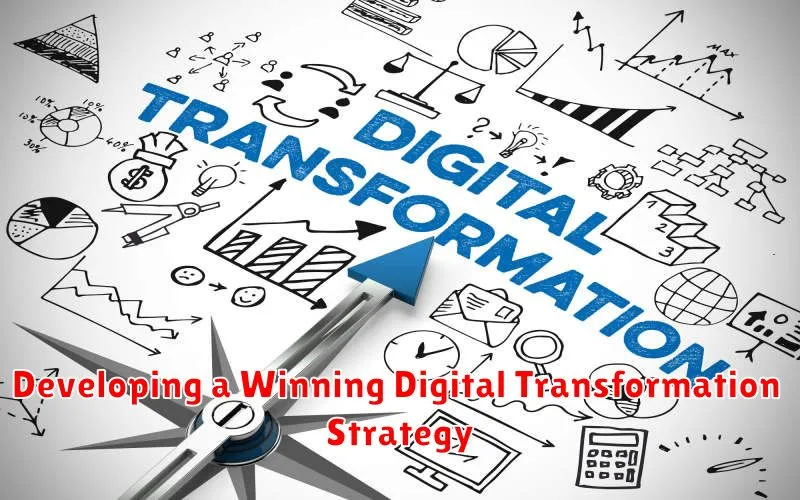
In today’s rapidly evolving technological landscape, businesses are under immense pressure to adapt and embrace digital transformation. A winning digital transformation strategy is essential for companies to thrive in the digital age. It involves a holistic approach that encompasses all aspects of an organization, from its culture to its operations and customer interactions.
Defining Your Digital Transformation Goals
The first step in developing a winning strategy is to clearly define your digital transformation goals. What do you hope to achieve through digital transformation? Do you aim to improve customer experience, enhance operational efficiency, or enter new markets? By setting specific, measurable, achievable, relevant, and time-bound (SMART) goals, you can create a roadmap for success.
Understanding Your Current State
Before embarking on any transformation journey, it is crucial to assess your current state. This involves conducting a thorough digital maturity assessment to identify your strengths, weaknesses, and areas for improvement. This assessment will help you understand where you stand in terms of digital capabilities and identify the gaps that need to be addressed.
Developing a Roadmap and Implementation Plan
Once you have defined your goals and assessed your current state, it’s time to develop a digital transformation roadmap. This roadmap should outline the key initiatives, projects, and timelines for achieving your objectives. It is essential to prioritize initiatives based on their impact and feasibility. You should also develop a comprehensive implementation plan that includes resources, budget, and responsibilities.
Embracing a Data-Driven Culture
Digital transformation is heavily reliant on data. It is essential to embrace a data-driven culture throughout your organization. This involves collecting, analyzing, and utilizing data to make informed decisions and drive innovation. Investing in data analytics tools and training employees on data literacy will empower them to harness the power of data.
Investing in Technology and Infrastructure
A successful digital transformation requires significant investment in technology and infrastructure. This includes cloud computing, artificial intelligence, machine learning, and other emerging technologies. It is essential to choose technologies that align with your strategic goals and provide a scalable solution for your future growth.
Building a Strong Digital Workforce
Digital transformation is not just about technology; it’s also about people. You need a strong digital workforce that is skilled, adaptable, and innovative. This involves investing in employee training and development, fostering a culture of learning, and attracting top digital talent.
Measuring and Monitoring Progress
It is crucial to measure and monitor the progress of your digital transformation journey. This involves setting key performance indicators (KPIs) to track your progress towards your goals. Regularly review your KPIs and make adjustments to your strategy as needed. By continuously monitoring and evaluating your performance, you can ensure that you are on track to achieve your desired outcomes.
Conclusion
Developing a winning digital transformation strategy requires careful planning, execution, and ongoing monitoring. By following the steps outlined above, businesses can successfully navigate the digital age and position themselves for long-term success. Remember that digital transformation is a continuous journey, and it’s important to adapt and evolve your strategy as technology and market conditions change.
Overcoming Challenges in Digital Transformation Implementation
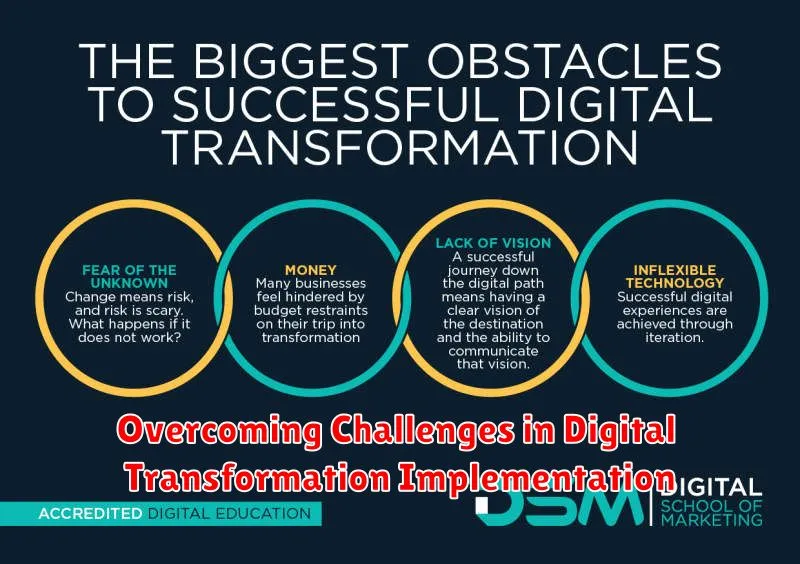
Digital transformation is a journey that every organization needs to embark on to stay competitive in today’s rapidly evolving business landscape. It involves leveraging technology to improve operations, enhance customer experiences, and create new business models. However, the path to digital transformation is fraught with challenges that can hinder progress and even lead to failure. This article delves into some of the most common challenges and provides insights into overcoming them.
1. Resistance to Change
One of the biggest hurdles in digital transformation is resistance to change. Employees may be apprehensive about adopting new technologies, processes, and ways of working. This resistance can stem from fear of job security, lack of understanding of the benefits of transformation, or simply a preference for the status quo. To overcome this challenge, organizations need to communicate effectively the need for change, involve employees in the transformation process, and provide adequate training and support.
2. Lack of Clear Vision and Strategy
Without a clear vision and strategy for digital transformation, organizations can easily get lost in a maze of technologies and initiatives. A well-defined strategy should outline the desired outcomes, prioritize key areas for transformation, and allocate resources effectively. It’s crucial to involve stakeholders in developing the strategy and set realistic goals that are aligned with business objectives.
3. Technology Challenges
Digital transformation involves implementing new technologies and integrating them with existing systems. This can present a significant challenge, especially for organizations with legacy systems or a lack of in-house technical expertise. Organizations need to choose the right technologies, ensure compatibility with existing systems, and develop a robust IT infrastructure to support the transformation journey.
4. Data Management and Security
Digital transformation generates vast amounts of data, which needs to be managed effectively to extract valuable insights. Organizations need to establish robust data management and security practices to protect sensitive information and comply with regulations. Investing in data analytics tools and implementing security protocols are essential steps towards achieving data security and compliance.
5. Lack of Leadership Support
Digital transformation requires strong leadership support at all levels of the organization. Leaders need to be champions of change, provide resources, and motivate employees to embrace the transformation. Without adequate leadership support, initiatives can easily stall or fail to deliver the desired results.
Overcoming the Challenges
While the challenges of digital transformation are significant, they are not insurmountable. By adopting a strategic approach, embracing collaboration, and investing in the right resources, organizations can overcome these obstacles and unlock the full potential of digital transformation. Here are some key strategies:
- Establish a clear vision and strategy: Define the desired outcomes, prioritize key areas, and allocate resources effectively.
- Build a strong team: Assemble a team of skilled professionals with expertise in technology, data management, and change management.
- Communicate effectively: Keep employees informed about the transformation journey and address their concerns.
- Embrace a culture of innovation: Encourage experimentation and learning from failures to accelerate the transformation process.
- Partner with experienced providers: Leverage the expertise of technology vendors and consultants to overcome technical challenges.
Digital transformation is an ongoing process that requires continuous adaptation and improvement. By overcoming the challenges and embracing the opportunities, organizations can position themselves for success in the digital age.
Measuring the Success of Your Digital Transformation Journey
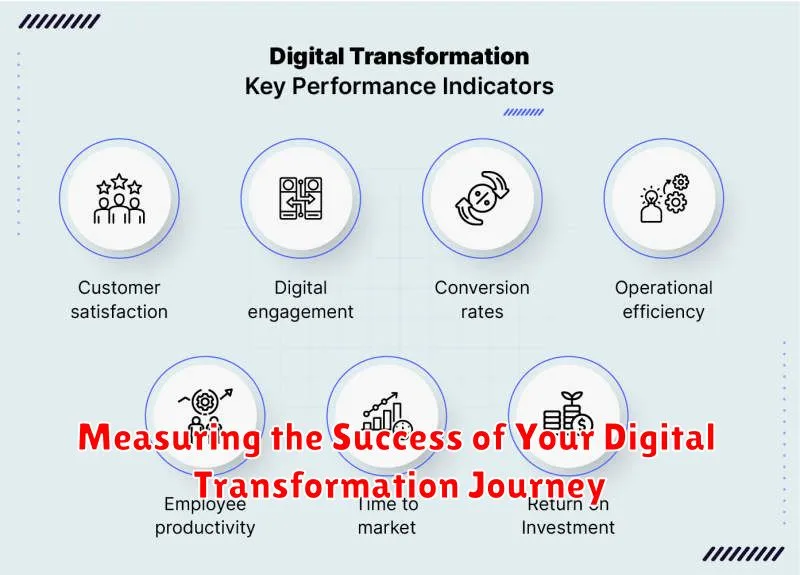
Digital transformation is a complex and multifaceted process that can bring significant benefits to businesses. However, it’s crucial to have a clear understanding of how to measure the success of your digital transformation journey. This will help you track progress, identify areas for improvement, and ultimately demonstrate the value of your initiatives to stakeholders.
Defining Your Metrics
The first step in measuring success is to define your metrics. What are the key goals you’re trying to achieve with your digital transformation? Are you looking to increase revenue, improve customer satisfaction, or streamline internal operations?
Once you have a clear understanding of your goals, you can develop metrics that align with them. For example, if you’re aiming to increase revenue, you might track metrics like website traffic, conversion rates, and average order value.
Key Performance Indicators (KPIs)
KPIs are specific, measurable, achievable, relevant, and time-bound metrics that help you track progress towards your goals. Here are some examples of KPIs that can be used to measure the success of digital transformation:
- Customer Acquisition Cost (CAC): This metric measures the average cost of acquiring a new customer.
- Customer Lifetime Value (CLTV): This metric represents the total revenue generated by a customer over their lifetime.
- Employee Net Promoter Score (eNPS): This metric measures employee satisfaction and engagement.
- Time to Market: This metric measures the time it takes to develop and launch new products or services.
Data Collection and Analysis
Once you have defined your metrics and KPIs, you need to collect data to track progress. This data can come from various sources, including website analytics, customer relationship management (CRM) systems, and internal performance reports.
It’s important to analyze the data regularly to identify trends and patterns. This will help you understand what’s working and what needs improvement.
Continuous Improvement
Digital transformation is an ongoing process. It’s not a one-time event, but rather a continuous journey of improvement. The success of your digital transformation journey is measured through constant evaluation, adaptation, and refinement.
By regularly reviewing your metrics and KPIs, you can identify areas where you can optimize your processes and technologies. This will help you achieve your goals and maximize the value of your digital transformation initiatives.
Real-World Examples of Successful Digital Transformation

Digital transformation is not a fad, it’s a necessity. Companies that fail to embrace it risk being left behind in a rapidly evolving market. But what does successful digital transformation look like in practice? Let’s explore some real-world examples of companies that have embraced digital transformation and achieved remarkable results.
Netflix: From DVD Rentals to Streaming Giant
Netflix’s story is one of the most inspiring examples of digital transformation. Starting as a DVD rental service, Netflix recognized the potential of streaming technology and pivoted its entire business model. They invested heavily in building a robust streaming platform, creating original content, and personalizing user experience. This shift catapulted them into the global leader in online entertainment, leaving traditional media companies struggling to catch up.
Amazon: From Online Bookstore to E-Commerce Domination
Amazon’s journey is another testament to the power of digital transformation. Beginning as an online bookstore, Amazon has expanded into a sprawling e-commerce empire. Their relentless focus on innovation, customer experience, and data-driven decision-making has led them to dominate online retail, disrupting countless industries along the way. From cloud computing with AWS to voice assistants with Alexa, Amazon continues to push the boundaries of digital transformation.
Tesla: Disrupting the Automotive Industry
Tesla’s story is about disrupting a traditional industry with cutting-edge technology. By leveraging its expertise in electric vehicles and battery technology, Tesla revolutionized the automotive landscape. Their focus on sustainability, performance, and autonomous driving technologies has attracted a loyal customer base and forced other automakers to accelerate their own electric vehicle development.
Conclusion
These examples demonstrate that digital transformation is not just about technology; it’s about embracing a mindset of continuous innovation, adapting to changing market dynamics, and putting the customer at the heart of everything. Companies that embrace this mindset are poised to thrive in the digital age, while those that resist will face an uphill battle.
Future Trends Shaping the Digital Transformation Landscape
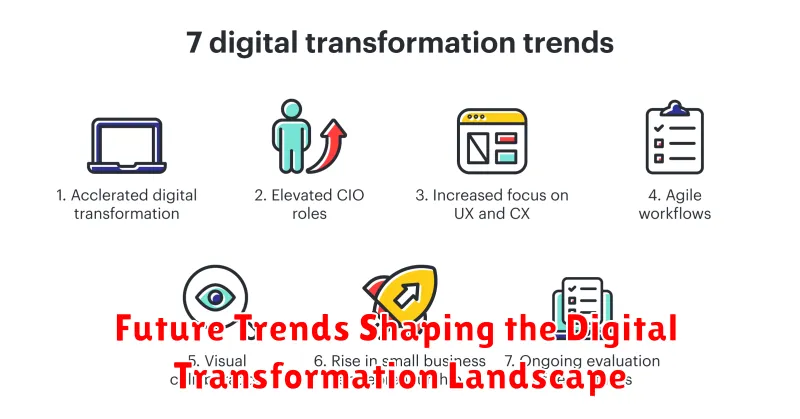
The digital transformation landscape is constantly evolving, driven by technological advancements and changing consumer expectations. As we move into the future, several key trends will continue to shape this landscape, impacting businesses across all industries. Understanding these trends is crucial for organizations seeking to stay ahead of the curve and leverage the power of digital transformation.
1. The Rise of Artificial Intelligence (AI)
AI is rapidly becoming ubiquitous, automating tasks, improving efficiency, and providing valuable insights. From chatbots and virtual assistants to predictive analytics and machine learning, AI is revolutionizing how businesses operate.
2. The Power of Data and Analytics
Data is the lifeblood of digital transformation, and organizations are increasingly leveraging it to make informed decisions and drive innovation. Big data analytics, data visualization, and predictive modeling are becoming essential tools for gaining insights from vast amounts of data.
3. The Importance of Cybersecurity
As businesses become increasingly reliant on digital technologies, cybersecurity threats are becoming more sophisticated. Data breaches and cyberattacks pose significant risks, making robust cybersecurity measures essential for protecting sensitive information and maintaining customer trust.
4. The Growth of the Internet of Things (IoT)
The IoT is connecting billions of devices, from smartphones and smart homes to industrial equipment and vehicles. This connectivity provides vast opportunities for businesses to collect data, automate processes, and create new products and services.
5. The Evolution of Cloud Computing
Cloud computing has become an integral part of digital transformation, offering scalability, flexibility, and cost savings. Cloud-native applications, serverless computing, and edge computing are emerging trends that are further transforming the cloud landscape.
6. The Focus on User Experience (UX)
Consumers now expect seamless and personalized digital experiences. Businesses are prioritizing UX design, mobile optimization, and personalized content to deliver exceptional user experiences across all touchpoints.
7. The Importance of Agility and Adaptability
The digital transformation landscape is constantly changing, making agility and adaptability essential for businesses to thrive. Organizations need to embrace continuous improvement, experimentation, and rapid iteration to keep pace with evolving trends.
By embracing these future trends, businesses can unlock the full potential of digital transformation, drive innovation, and create a competitive advantage in the ever-evolving digital landscape.
Embracing Continuous Innovation in the Digital Age

In today’s rapidly evolving digital landscape, the ability to adapt and innovate continuously is no longer a competitive advantage; it’s a necessity for survival. Organizations that fail to embrace continuous innovation risk falling behind, becoming irrelevant in a world where disruption is the norm.
Continuous innovation is the ongoing process of developing and implementing new ideas, products, services, and processes to meet changing customer needs and market demands. It’s a mindset that encourages experimentation, learning from failures, and constantly seeking ways to improve.
Here are some key principles for embracing continuous innovation:
Foster a Culture of Innovation
A culture that values experimentation, risk-taking, and collaboration is essential for continuous innovation. Encourage employees to share ideas, provide feedback, and challenge the status quo. Create a space where failure is seen as a learning opportunity, not a punishment.
Embrace Agile Methodologies
Agile methodologies, like Scrum and Kanban, break down large projects into smaller, manageable chunks, allowing for rapid iterations and feedback loops. This approach enables organizations to adapt quickly to changing market conditions and customer demands.
Invest in Technology and Data
Emerging technologies like artificial intelligence (AI), machine learning (ML), and big data analytics can provide valuable insights into customer behavior and market trends, enabling organizations to develop innovative products and services that meet evolving needs.
Focus on Customer-Centricity
Understanding and responding to customer needs is at the heart of continuous innovation. Organizations must actively engage with their customers, gather feedback, and leverage insights to develop solutions that truly address their pain points and aspirations.
Embrace a Growth Mindset
Continuous innovation requires a growth mindset, a belief that abilities and intelligence can be developed through effort and persistence. Encourage employees to learn new skills, explore new technologies, and embrace challenges as opportunities for growth.
In the digital age, continuous innovation is not just a strategy; it’s a way of life. Organizations that embrace this mindset, foster a culture of innovation, and leverage the power of technology and data will be well-positioned to thrive in the face of constant change.

